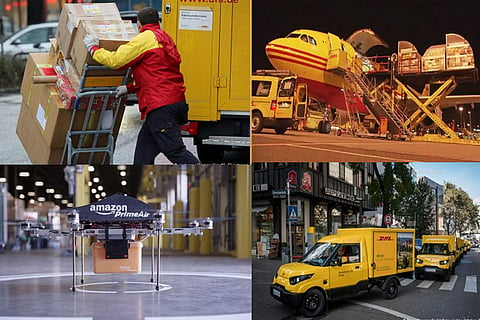

Chennai
But ever since COVID-19 lockdowns were announced in March, the likes of Hermes, DHL and UPS have been running at full tilt as shoppers make more and more purchases online.
In the UK, e-commerce made up 28.1% of total retail sales this October — a jump of almost 50% compared with October 2019. It is a trend that looks set to stay. A recent survey by McKinsey consultancy in Germany predicts an increase between 25% and 40% in consumers who do most or all their shopping online once the pandemic is over. This is massive news for the parcel delivery industry. In July, Hermes UK announced it would hire more than 10,000 new staff to meet continued growth in online shopping. But it isn’t just extra manpower that’s required. The events of 2020 are turbocharging the industry’s shift from solid and unspectacular to dynamic, competitive and innovative as it attempts to solve its toughest challenge: the ‘last mile’ of delivery.
In the not-too-distant future, that will mean autonomous drones and delivery robots buzzing around our cities. Indeed, trials for both have already been carried out by Google and Amazon, as well as ambitious startups like Starship, Wingcopter and Matternet. But while automation is becoming fundamental in shipping and distribution centers, the last mile is still reliant on human involvement. For the foreseeable future, technology in this part of logistics will be more about supporting people rather than replacing them.
With parcel volumes continuing to rise, improving efficiency is a major focus for carriers. Many have adopted AI-powered route planning systems to shorten journey times, while alternative drop-off locations now include lockers, local convenience stores, garages and even cars to reduce the number of unsuccessful deliveries.
“People not being in is one of the biggest causes of wasted journeys,” Thomas Zunder, principal research associate at the Future Mobility Group of Newcastle University in northern England, told DW.
For now, the majority of parcel deliveries are still carried out by van, but increasingly congested streets are forcing delivery firms to seek alternatives. UPS and DHL have begun to introduce electric bicycles, while UK-based startup Zedify delivers almost exclusively with cargo bikes and trikes.
“Once you get into city centers, vehicles can’t compete with us in terms of productivity and cost,” co-founder Sam Keam told DW. Sometimes, getting off the road entirely and onto the sidewalk is the best way to go.
“Automated walking robots will start to follow the delivery person and provide extra cargo capacity but retain the human competencies,” says Zunder. UPS has recently introduced such “e-walkers,” while Hermes has been trialling “street porters” in which a van acts as a mobile refill station for a handful of couriers, who deliver packages on foot.
— This article has been provided by Deutsche Welle
Visit news.dtnext.in to explore our interactive epaper!
Download the DT Next app for more exciting features!
Click here for iOS
Click here for Android